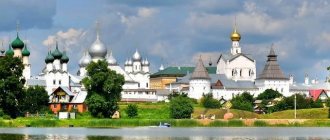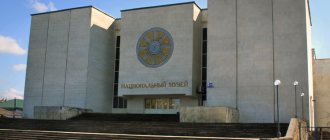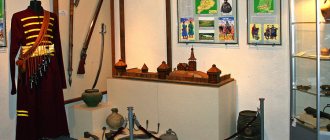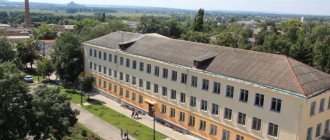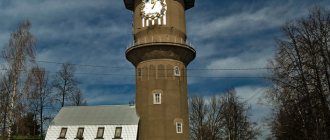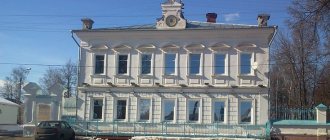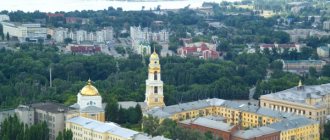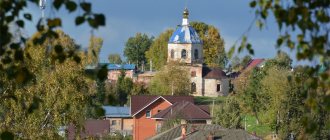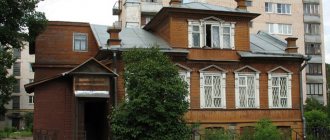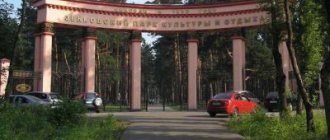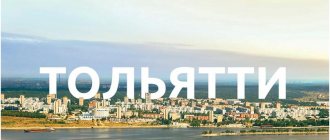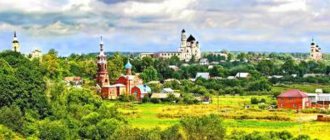Rostov the Great is a small ancient city with a population of only 30 thousand people, annually attracting hundreds of tourists with its attractions.
This city of enormous cultural significance with a long history is included in the list of cities of the Golden Ring of Russia. The Rostov Kremlin, located in the central part of the city, can be called the main attraction of Rostov the Great. Not intended for defense, the complex consisting of several buildings was built in the 17th century as the residence of the first persons of the local diocese. The Rostov Kremlin combines several churches, a belfry, 11 towers and other small buildings. Temples and museums are open to the public.
INTERESTING. The Rostov Kremlin can be seen in the famous film by L. Gaidai “Ivan Vasilyevich Changes His Profession”, it was here that footage of the royal life was filmed, and the ringing of the bells of the Belfry can be heard in the films “Peter the Great”, “War and Peace”, etc.
Assumption Cathedral
The exact date of construction of the Assumption Cathedral, which is part of the Rostov Kremlin complex, cannot be established; the temple burned and was rebuilt many times; the brick building of the cathedral from 1512 has survived to this day. Next to the temple there is a belfry. The largest of the 15 bells weighs 32.7 tons.
Inside the cathedral, frescoes from the 16th–17th centuries found during restoration, an iconostasis in the Baroque style, and the relics of Rostov saints and ruling bishops are preserved.
Rostov Kremlin
Already during the reign of Yuri Dolgoruky (beginning of the 11th century), Rostov was a rich and populous city, and the Great received the respectful “nickname” when Moscow was just beginning to be built. In terms of size, Rostov was second only to Kyiv and Novgorod.
In the 1650s. Construction of the Rostov Kremlin began on the shores of Lake Nero. But it was built not as a defensive structure, but as the residence of a metropolitan who dreamed of creating a Garden of Eden, surrounded by high walls and towers. As a result, the Kremlin turned out to have some architectural simplifications, which, in the event of a military threat, would have to be quickly eliminated (wide entrance gates, lack of sole loopholes in the towers, etc.).
Assumption Cathedral, Odigitrievskaya Tower and the fence of the Rostov Kremlin
Frankly, the Metropolitan’s idea was a success, and the ensemble of the Rostov Kremlin turned out to be truly laconic and attractive, deservedly receiving the status of the main attraction of the city! Many tourists, without a shadow of a doubt, consider the Rostov Kremlin the most beautiful of all the Kremlins they have seen before.
Ensemble of the Rostov Kremlin
The diagram of the Rostov Kremlin clearly shows that its entire territory is divided into three parts: Cathedral Square (on the left), the Bishop's Courtyard (in the center) and the Metropolitan Garden (on the right).
Scheme of the Rostov Kremlin
Reliable prices for visiting the Rostov Kremlin can be found on the official website.
Cathedral Square
Having passed under the Holy Gate , we find ourselves on Cathedral Square. This is not the main entrance to the Kremlin, but this way we can explore its entire territory in chronological order.
Holy Gate - entrance to the Rostov Kremlin
In the center of Cathedral Square stands the white-stone Assumption Cathedral , built in 1508-1512. It was built on the site of three of its predecessors, which went down in history along with devastating fires.
Assumption Cathedral in the Rostov Kremlin
A little later, the domes of the cathedral were redone, and an elegant porch was added to the south side - this gave the cathedral a more solemn appearance in connection with the construction of the metropolitan courtyard that began nearby.
Assumption Cathedral in the Rostov Kremlin
Elegant porch of the Assumption Cathedral in the Rostov Kremlin
In 1682-1687, next to the Assumption Cathedral, a laconic four-tier belfry with the Church of the Entry of the Lord into Jerusalem . The belfry is decorated with 15 bells, the largest of which weighs about 33 tons and is called “Sysoy”.
Belfry of the Assumption Cathedral and Chapel Tower of the Rostov Kremlin
Now let's go to the territory of the Bishop's Courtyard under the gateway Church of the Resurrection .
Gate Church of the Resurrection in the Rostov Kremlin
The composition with the church, gate and two round towers is completely symmetrical. Passing through the gate symbolized the entrance to the Kingdom of Heaven. The visitor, passing from the Assumption Cathedral to the Church of the Resurrection, figuratively moves from death to life (from “Asleep” to “Resurrection”).
Gate Church of the Resurrection in the Rostov Kremlin
Bishop's Court
The Bishop's Courtyard is the largest, most visited and most photographed part of the Rostov Kremlin. This territory contains the largest number of architectural attractions.
Here are some panoramic views of the Bishop's Courtyard:
Bishop's Courtyard of the Rostov Kremlin
Bishop's Courtyard of the Rostov Kremlin
Bishop's Courtyard of the Rostov Kremlin
Now let’s examine the Bishop’s Courtyard in more detail!
The Gate Church of the Resurrection , under which we crossed from the Cathedral Square to the Bishop's Courtyard. It was one of the first churches erected during the large-scale construction of the Rostov Kremlin.
Church of the Resurrection (center) and the Assumption Cathedral (left) in the Rostov Kremlin
To the right of the Church of the Resurrection is the building of the Judgment Order . Those who were guilty (whether the clergy of the diocese or lay people) were taken to a small courtyard behind the building of the Judicial Order, where the trial was carried out. Most often these were cases related to heresy, witchcraft and adultery.
Court order in the Rostov Kremlin
The bright and attractive Church of Hodegetria was built somewhat later than the main ensemble (in 1692-1693), so it is not included in the Kremlin walls, but was built next to it. The church was built in the Moscow Baroque style and painted with diamond rustication.
Church of Hodegetria in the Rostov Kremlin
The Odigitrievskaya Tower peeks out from behind the church.
Church of Hodegetria in the Rostov Kremlin
The church with dark green domes is the gate church of St. John the Evangelist , built in 1683. Her story is somewhat tragic, but with a good ending! Since its construction, the church burned down twice, they began to use it for warehouses, and even wanted to dismantle it. Fortunately, the city community defended the architectural monument.
Church of St. John the Evangelist (left) and Church of Hodegetria (right) in the Rostov Kremlin
In the middle of the 20th century, the church underwent a major renovation, and now its gates serve as the central entrance to the Rostov Kremlin.
Porch of the Church of St. John the Evangelist in the Rostov Kremlin
The Red Chamber is a huge two-story stone mansion complex, intended to accommodate visiting sovereigns. The name “Red” comes from the old Russian “Beautiful”. A special decoration of the State Choir is the massive porch with two tents.
Red Chamber in the Rostov Kremlin
The large yellow building in the spirit of classicism is the Samuel building , built under Archbishop Samuel and serving as the metropolitan's chambers. Part of the building was occupied by the Treasury Department, which was in charge of all financial affairs of the diocese. After its construction, the second and third floors were added to the building in different centuries, and then the external decor was changed to classicism.
Samuel's building in the Rostov Kremlin
We are all well aware of the film “Ivan Vasilyevich Changes His Profession.” So, the footage of ancient Rus' was filmed in the Rostov Kremlin! Fortunately, now you don’t need a time machine to travel to the past - on the territory of the Rostov Kremlin, any tourist can rent “royal outfits” for every taste, color and size and fully enjoy the surrounding atmosphere! The fitting room is located next to the Samuel building, near the large staircase.
Very nice, king!
Hidden in the shade of the trees is a low, red building called the Cellar House. Initially, the building was one-story and served as outbuildings: “refrigerators” filled with ice from the lake were installed in the cellars, and dry food warehouses (driers) were located above the cellars. Since 1698, a second floor was added to the building, where residential cells were located.
Cellar house in the Rostov Kremlin
On the right, a long L-shaped building adjoins the cellar house through an elegant passage - the Hierarchical Chambers .
The transition between the House on the Cellars and the Hierarchical Chambers in the Rostov Kremlin
Behind the passage looks out the Water Tower , on which there is an observation deck. Very soon we will climb it too!
The transition between the House on the Cellars and the Hierarchical Chambers in the Rostov Kremlin
The long Hierarchical L-shaped chambers also initially served as utility buildings. They housed a glacier, a drying room, a brewery, a cookery and others. Later these buildings were adapted for living quarters.
Hierarchical chambers in the Rostov Kremlin
The well looks very ancient!
Well in the Rostov Kremlin
A nook of amazing medieval beauty! Here you can see the Prince’s Tower (brick wall on the left), and the White Chamber (the protruding part of the building on the right), and the magnificent arched passages connecting them...
The White Chamber was the refectory, where the Metropolitan held ceremonial meals. A distinctive feature of the refectory are the windows, which were quite large for that time and decorated with stone weights.
Prince's mansion and White Chamber in the Rostov Kremlin
The prince's towers , as well as the Church of Hodegetria, are decorated in rustic style. It is interesting that the princes never lived here, but in any case, this building was definitely intended for living.
Prince's mansion in the Rostov Kremlin
Behind the transition between the Prince's Towers and the Hierarchical Chambers the Garden Tower peeks out.
The transition between the Prince's towers and the Hierarchical chambers in the Rostov Kremlin
Of all the buildings of the Bishop's Court, we only have to examine the Church of the Savior in the Entrance . The church was built on another utility building, or rather on a bakery and in the entryway. To get to the Church of the Savior on the Entrance, you need to climb the stairs to the roof of the neighboring building. The massive openwork porch is the entrance to the church! And the small door to the right is the entrance to the refectory (White Chamber).
Entrance to the Church of the Savior on the Entrance in the Rostov Kremlin
From here you can take some nice shots of the Bishop's Court, and then go to the observation deck of the Water Tower
Bishop's courtyard in the Rostov Kremlin
Observation deck of the Rostov Kremlin
Be sure to go up to the observation deck of the Rostov Kremlin, located on the Water Tower. From here you can enjoy wonderful views of the Kremlin and other attractions of Rostov the Great.
View of the Rostov Kremlin from the Water Tower
The Rostov Kremlin is incredibly lucky! Look at all these buildings, they are all genuine, and not a copy recreated from ruins. Neither during the Great Patriotic War, nor during the Soviet regime, the Kremlin was not damaged; its buildings were not demolished or dismantled brick by brick, as happened with historical buildings in many other Russian cities.
View of the Rostov Kremlin from the Water Tower
The most destructive event for the Rostov Kremlin occurred in 1953, when a tornado swept over the city, destroying the entire roof and throwing off the domes of cathedrals and churches (all buildings survived). At that time, the Kremlin had been abandoned for a long time and had become very dilapidated. And the tornado reminded us just in time that it was time to start restoration.
Assumption Cathedral (right) and the Gate Church of the Resurrection (left) in the Rostov Kremlin
And here is Lake Nero, and the Church of the Savior in the Entrance in the foreground. In the center of the frame you can see the Church of Gregory the Theologian, which is located on the territory of the Metropolitan Garden. If you look closely, you can see the outlines of the Spaso-Yakovlevsky Demetrius Monastery on the horizon.
Church of the Savior on the Entrance in the Rostov Kremlin
Church of Gregory the Theologian in the Rostov Kremlin
Church of the Savior on the Entrance in the Rostov Kremlin
Hierarchical L-shaped chambers and their lovely chimneys, more like gnome houses than chimneys.
Chimneys of the Hierarchical Chambers in the Rostov Kremlin
, the Nativity Convent modestly nestles . From the observation deck you can clearly see the Church of the Nativity of the Blessed Virgin Mary and the Church of St. Nicholas on Podozerka.
Nativity Convent in Rostov the Great
Also from the watchtower you can see entire blocks of the city's historical buildings. Shopping arcades and Gostiny Dvor occupied several streets at once, which once again reminds how rich and successful the ancient city of Rostov was. The oldest of the trading houses date back to the mid-18th century.
Gostiny Dvor and the Church of the Savior at Torg in Rostov the Great
Epiphany Abraham Monastery
The Epiphany Abraham Monastery is the oldest monastery in Rostov, located on the shore of Lake Nero. According to legend, the monastery was built on the site of the overthrow of the idol of Veles by the Venerable Abraham of Rostov with a staff, which John the Theologian himself handed to him upon meeting. Over time, the believers who came to the Reverend formed a monastery.
The monastery suffered greatly during the Polish invasions of Rostov, and later with the advent of Soviet power. From 1994 to this day, restoration work has been carried out in the monastery, there are workshops and a refectory at the monastery.
Neighborhood
Spaso-Yakovlevsky Dimitriev Monastery
From the lake you can see the ancient Spaso-Yakovlevsky Dimitriev monastery, founded in the 14th century. Most of the surviving buildings were built later, and their architecture is significantly different from the Kremlin - it is more classical and baroque style. The monastery's cathedrals will also be of interest for their ancient frescoes.
Church of St. John the Evangelist on Ishna
Another important attraction is the Church of St. John the Theologian, which is located in the vicinity of Rostov in the Bogoslov area. It was built in 1687 and is a unique wooden monument preserved from that time. You can see many carved elements in the temple. Inside there is a copy of the Royal Doors from 1562.
village of Bogoslov
Working hours: 10:00-17:00
Entrance: 80 rub.
Boris and Gleb Monastery
The Boris and Gleb Monastery will be encountered by those traveling along the “Golden Ring” on the road between Rostov and Uglich. The construction of the temple began in 1363 by the hermits Paul and Feodor, who received the blessing of Sergius of Radonezh. This monastery was especially loved and often visited by Moscow princes, and therefore was richly maintained. A large number of believers coming to the monastery from all sides also attracted merchants with their goods. So around the Borisoglebsky monastery a large village arose - Borisoglebsky settlements, where holiday fairs were often held.
Under Soviet rule, the People's Museum was opened in the monastery. In 2015, all of its property was returned to the monastery. The Boris and Gleb Monastery houses many Orthodox shrines that can perform miracles, give hope and heal believers.
Story
Now Rostov is primarily a city in the south of Russia, but it was Rostov in the Yaroslavl region that appeared nine centuries earlier and was once very important.
The heyday dates primarily from the 11th to 13th centuries, when it was the center of the Rostov-Suzdal principality. It was the administrative and religious center of the region. However, later Moscow acquired greater strategic influence, which subsequently deprived the principality of political independence and left Rostov only with important religious powers. But then the main diocese was moved to Yaroslavl, depriving it of this function. Then it becomes a shopping center with the largest fair in the area.
Since the 19th century, a real decline begins: gradually, only the architecture remains of its former greatness, and it becomes a small county town. Despite the fact that now it is practically not developing, Rostov the Great has preserved an impressive historical heritage, attracting many tourists traveling along the Golden Ring.
Trinity Sergius Varnitsky Monastery
A few kilometers from Rostov in 1427, on the site where Sergius of Radonezh had previously been born and raised, local Archbishop Ephraim founded a temple. Initially, the building was wooden, and only by the middle of the 18th century, thanks to the funds of Bishop Afanasy Volsky, it became stone. Later, with donations from Rostov merchants, the Winter Church and the Church of the Presentation were built.
During the Soviet era, the monastery was almost completely destroyed, and only the Vvedenskaya Church and a few cells survived.
Since 1995, during the process of restoration work, the monastery was practically rebuilt, bringing the architecture of the building as close as possible to its original appearance.
Temples, cathedrals and monasteries - shrines of Rostov the Great
Abrahamievo-Epiphany Monastery (located at: Zhelyabovskaya St., 32) is a place that is definitely worth visiting.
The foundation of the Abrahamic-Epiphany Monastery dates back to 1080.
And not only because the monastery itself is beautiful and majestic, but also because the place on which it was built is a place of ancient power and great miracle. Once upon a time there was a pagan temple here. Local Slavs worshiped the god Veles. According to legend, the hermit Abraham crushed the idol with the help of the rod of John the Theologian. Approaching the walls of the monastery, you realize how old the forest surrounding it is, and how everything around is saturated with ancient History.
The monastery itself was founded in the 10th–11th centuries, and for a long time the buildings were wooden. Now the main temple of the monastery is the Epiphany Cathedral - an ancient, stone, crowned with five domes.
One of the most beautiful and oldest monasteries is the Women's Bogolyubov. The most beautiful church of the monastery is Rozhdestvenskaya. It is in it that the Tikhvin Icon of the Mother of God is located. An interesting place is the monastery library, the entrance to which is open to tourists. Here you can look at (and even leaf through) ancient books written more than 300 years ago.
It is also worth visiting the Spaso-Yakovlevsky Monastery of the city (located at Engels St., 44). This is a magnificent architectural ensemble, crowned with green, blue and gold domes. The main churches of the monastery, Zachatievsky and Dmitrievsky, are decorated with perfectly preserved frescoes of the 16th-18th centuries. The construction of the monastery took place in the 14th century by order of the Rostov Archbishop Jacob. During the reign of Soviet leaders, the monastery fell into disrepair, but has now been completely restored.
The Monastery of the Nativity of the Blessed Virgin Mary is a small and very “gentle” monastery. Its white walls and silver domes are visible from afar. It is known for certain that the monastery was founded in the 14th century by Saint Theodore (native nephew of S. Radonezh). You can find it on Sovetskaya Square, building 14. Over the course of several centuries, the monastery was rebuilt more than once. It acquired its modern appearance only towards the end of the 19th century.
St. Nicholas Church on Podozerie is a temple with a very unusual history. This is the first shrine built in Russia after the decree of Emperor Peter Alekseevich banning any stone construction outside the walls of St. Petersburg. Although, there is information that a stone temple appeared here long before 1745. Located on Sako street, building 20.
Boris and Gleb Monastery, located 20 km from the city, is unique. It is more of a fortress than a monastery. Looking at the high and wide walls, towers with loopholes, powerful masonry of churches, you understand how the local monks could meet the enemy. These were not just servants of the Lord, they were warriors who were ready to do anything not to let the enemy into the city. The most beautiful churches of the monastery are the Sretenskaya Church, the Annunciation Church and the Cathedral of Boris and Gleb.
Also not far from the city is the Trinity-Sergius Varnitsky Monastery . It is strikingly different from Borisoglebsky. This is a very “ornate” monastery, the white and purple walls of its temples do not evoke any other feelings other than joy and peace. The monastery was built in the 19th century in honor of Sergius of Radonezh, who was from these places. On the territory of the temple there is a holy spring, from which anyone can take water.
Not far from Gostiny Dvor there is the ancient Church of the Savior on Torg or the Ruzhnaya (without parish) Church (address: Sovetskaya Square). This is probably one of the oldest churches located on the territory of modern Russia. Mentions of it can be found in chronicles compiled in the 13th century. The church took on its modern appearance in the 17th century and its unique feature is the absence of an iconostasis. All walls inside are decorated with frescoes.
The Church of the Ascension over the tomb of Isidore the Blessed (address: K. Marx St.) was erected by order of Ivan the Terrible. It is believed that under the church there is a grave with the relics of Isidore the Blessed. The church was rebuilt many times, maintaining its authentic appearance.
If you want to see all the churches of Rostov the Great, then don’t be lazy and go to the village of Ishnu.
Here is the ancient wooden Church of St. John the Evangelist. Over time, the walls have acquired a unique burgundy hue, and the roof, on the contrary, has turned green. The church stands in the middle of a large green meadow, on the edge of a classic Russian village, and everything around just “breathes” peace.
It is also worth paying attention to such temples in the city as the Church of the Intercession of the Blessed Virgin Mary (Leninskaya St., 36), the Church of the Ascension of the Lord, the Church of St. Andrew Stratelates and others.
The Church of the Intercession of the Blessed Virgin Mary was built in 1795 on the site of two wooden churches - the summer Intercession and winter Nikolsky, which burned down the same year. Icons from both churches were saved and moved to the new church, which soon became one of the richest in decoration in Rostov
Did you know that: in Rostov the Great, one temple was built for just a few courtyards.
Spaso-Yakovlevsky Monastery
The Spaso-Yakovlevsky Cathedral contains the relics of St. James and Dmitry of Rostov, the first of whom founded the holy monastery, building a wooden church after being expelled from his hometown for the release of a woman sentenced to death, and under the second, the monastery achieved unprecedented power and prosperity. The monastery was visited several times by royalty.
The heyday of the monastery was cut short with the advent of Soviet power; in 1923 the monastery was closed, the monks were dispersed, the property was looted, the premises were given over to military warehouses. Only in 1991 did the restoration of the monastery begin, returning it to its former life.
INTERESTING On the territory of the monastery there is a spring with healing holy water.
Where to go in winter and what to see
Arriving in Rostov the Great in winter, you should definitely take a walk around the city (if it is not very cold) and visit the Trading Rows (address: 50th Anniversary of October Street).
These shopping arcades were erected near the walls of the Kremlin back in the 19th century, and both then and now they are the center of the city’s trading life.
Be sure to look at the gymnasium named after. A. L. Kekina .
This is a unique educational institution, which has no analogues anywhere in Russia. Two buildings (for schoolchildren and for teaching staff) of the gymnasium were built with money from the Rostov merchant A. Kekin, built in the classical style and beautifully decorated with stucco molding and columns.
If it’s very cold, then go explore the city’s museums.
Be sure to visit the White Chamber. The exhibition here is simply unique (mainly church antiquities) and covers the period from the 11th to the 19th centuries. On the second floor of the museum there is also an exhibition of 19th century interiors. The White Chamber is located on the territory of the Kremlin, as well as the Red Chambers or the Sovereign Chambers, which are also worth a look. The interior of these luxurious premises will seem familiar, which is understandable, since this is where “Ivan Vasilyevich...” was filmed.
Next you need to go to the Museum of Rostov Merchants, located in the mansion of the merchant A. Kekin on Leninskaya Street, 32. Kekin is a legendary Rostov merchant, who bequeathed almost all of his fortune (almost 8 million rubles - a huge amount at that time) to the residents of Rostov for the construction of a gymnasium and university . The Museum recreates the life of the Rostov merchants of the 18th-19th centuries. Here you can find interior and household items, outfits, paintings and much more. The exhibition is incredibly rich.
After the Museum, don’t be lazy to walk to the building of the old Rolma manufactory, which once also belonged to A. Kekin.
It is worth noting: the merchant did not close the building of the Rolma manufactory even when it became unprofitable, trying to save jobs for the townspeople.
Art lovers should also visit the Khors art gallery. Here is a collection of paintings by Rostov artists.
Museum "The Frog Princess"
Travelers with children are recommended to stay at the Tsarevna-Frog guest house, which is located in a restored building built in 1790 and owned by the Malyshev merchants. Moreover, next to the house with a fabulous name there is a museum of the same name, the collection of which includes more than 2000 various frog figurines. In addition, visitors are offered various interactive games based on fairy tales. The creators of the museum believe that the fairy tale about the frog princess originated in Rostov, because one of the ancient tribes on this land revered the amphibian, considering it sacred.
IMPORTANT Visits to the museum are held in groups by appointment.
Photos of Rostov Veliky
Rostov Veliky: Attractions Photos Weather Map Hotels
Countries of the WorldRussiaCitiesRostov Veliky
1
This collection contains 150 photographs of Rostov the Great, its views, houses and attractions, which were taken by local residents, tourists and photographers. In order to view a photo album of a specific attraction, you need to go to the appropriate section on the object’s page. All photos of Russian cities and attractions are presented in high quality, we hope that this will help you get to know them better.
VKontakte facebook twitter
Photos of other Russian cities Photos of Moscow Photos of St. Petersburg Photos of Sochi Photos of Tula Photos of Yaroslavl Photos of Vladimir Photos of Voronezh Photos of Yekaterinburg Photos of Ryazan Photos of Tver Photos of Sevastopol Photos of Dmitrov Photos of Rostov the Great Photos of Ivanovo Photos of Orel Photos of Nakhodka Photos of Belgorod Photos of Bryansk Photos of Volgograd Photos of Kazan Photos of Kaluga Photos Krasnodar Photo Lipetsk Photo Nizhny Novgorod Photo Penza Photo Samara Photo Saratov Photo Smolensk Photo Tambov Photo Chelyabinsk Photo Anapa Photo Kolomna Photo Yuzhno-Sakhalinsk Photo Vladivostok Photo Grozny Photo Izhevsk Photo Kostroma Photo Kursk Photo Omsk Photo Perm Photo Rostov-on-Don Photo Ufa Photo Cheboksary Photo Chita Photo Kerch Photo Pushkin Photo Sergiev Posad Photo Murom Photo Yeisk Photo Abakan Photo Saransk Photo Dolgoprudny Photo Balashikha Photo Irkutsk Photo Kirov Photo Novosibirsk Photo Orenburg Photo Podolsk Photo Ulyanovsk Photo Essentuki Photo Magadan Photo Alushta Photo Mytishchi Photo Krasnoyarsk Photo Togliatti Photo Khabarovsk Photo Myshkin Photo Kaliningrad Photo Rybinsk Photo Stavropol Photo Suzdal Photo Tomsk Photo Tyumen Photo Pyatigorsk Photo Ukhta Photo Astrakhan Photo Blagoveshchensk Photo Murmansk Photo Novorossiysk Photo Pskov Photo Ulan-Ude Photo Gelendzhik Photo Uglich Photo Pitkyaranta Photo Arkhangelsk Photo Barnaul Photo Vologda Photo Yoshkar-Ola Photo Kemerovo Photo Kurgan Photo Magnitogorsk Photo Nalchik Photo Surgut Photo Taganrog Photo Yakutsk Photo Simferopol Photo Balakovo Photo Svetlogorsk Photo Ordzhonikidze Photo Zheleznovodsk Photo Engels Photo Komsomolsk-on-Amur Photo Armavir Photo Vladikavkaz Photo Makhachkala Photo Norilsk Photo Tuapse Photo Yalta Photo Torzhok Photo Ples Photo Alexandrov Photo Volgodonsk Photo Angarsk Photo Bratsk Photo Naberezhnye Chelny Photo Novokuznetsk Photo Syzran Photo Cherepovets Photo Sudak Photo Veliky Novgorod Photo Kislovodsk Photo Kalyazin Photo Mineralnye Vody Photo Kovrov Photo Belokurikha Photo Pereslavl-Zalessky Photo Sortavala Photo Derbent Photo Petrozavodsk Photo Syktyvkar Photo Feodosia Photo Novocherkassk Photo Vyborg Photo Kozelsk Photo Elista Photo Balaklava Photo Foros Photo Nizhnevartovsk Photo Petropavlovsk-Kamchatsky Photo Pechory Photo Salekhard Photo Tobolsk Photo Valdai Photo Yuryev-Polsky Photo Nizhny Tagil Photo Severodvinsk Photo Anadyr Photo Zadonsk Photo Khanty-Mansiysk Photo Priozersk Photo Vorkuta Photo Temryuk Photo Dzerzhinsk Photo Kirzhach Photo Gatchina Photo Kronstadt Photo Elabuga photo of the great Ustyug photo Maykop photo of the old Russa photo miass photo Hasavyurt photo of Shlisselburg photo Alupka photo bachisaray photo of Peterhof photo of the great Luke photo of the Baltiysk photo of Nevyansk photo of Nevyansk photo of Nevyansk photo Kidekshi photo Verkhoturye photo of the Ostashkovsk photo of Chernyakhovsk photo of the Ussuriyska photo Photo of Sterlitamak Photo of Zelenogradsk Photo of Neman Photo of Sovetsk Photo of Polessk Photo of Severomorsk Photo of Roslavl
Rostov Veliky
Description Attractions Photo Weather Map Hotels
See also: Photos of Sequoia National Park, Attractions of Saint Vincent and the Grenadines, Wallis and Futuna, Sierra Leone, Bishkek, Dar es Salaam, Coro Sea, La Scala Opera House
Lake Nero
Great Rostov is located on the western shore of the small but ancient Lake Nero, which is about 500 thousand years old. The first to settle here were representatives of the Finno-Ugric tribe Merya, who gave the name to the lake in their language. "Nero" means muddy, swampy.
At any time of the year you can find entertainment to suit your taste on the lake. You can stay both in city hotels and at comfortable recreation centers on the lake shore. Those who prefer a more secluded holiday can rent cottages in nearby villages. In summer it’s good to swim here, go on water and horseback rides, take a steam bath, and you can even go hang-gliding. In autumn and winter, the area, rich in a variety of game, attracts hunters. The caught prey can be immediately cooked in coastal cafes. Well, at any time of the year you can enjoy magnificent scenery and excellent fishing here. The muddy bottom of the lake serves as an excellent food source for many species of fish.
Rostov the Great - what a tourist must visit
Taking your map with you, you should definitely go to Selivanov’s mansion (located at 5 Okruzhnaya St.).
This is one of the most beautiful buildings in the city, decorated in Art Nouveau style. The owners of the mansion, father and son Selivanov, were well-known merchants and philanthropists in Rostov, very rich people, it is clear that their mansion was not inferior in beauty to those in the capital.
Another house that you need to pay attention to is the Vanchagov mansion (mansion address: intersection of Okruzhnaya and K. Marks streets). This house belonged to the merchant P.V. Vanchagov and was also built in the Art Nouveau style. It has an interesting pentagonal shape and lush decoration. Now the building houses a cadet school.
Within the walls of the Rostov Kremlin there is another interesting building - the House on the Cellars. This is a perfectly preserved building from the 18th century, still serving its intended purpose. Within its walls now, as before, there is a hotel, but no one forbids curious tourists to look at the interior of this ancient building.
Every tourist coming to Rostov Veliky should definitely visit the Enamel Museum-Gallery (address: Borisoglebskoe highway, 3). Be sure to buy some souvenir here for yourself or your loved ones.
This is interesting: enamel is a unique technique for decorating ceramic and metal products; it is not even painting, but rather a kind of mosaic.
Another must-visit place is the Lukova Sloboda Museum (address: Dostoevsky Street, 39). This is a small museum dedicated to a vegetable - onions.
Please note: in the Lukova Sloboda Museum you can satisfy not only your curiosity, but also your stomach. On the ground floor there is a themed cafe that serves all kinds of dishes, the main ingredient of which is, of course, onions.
